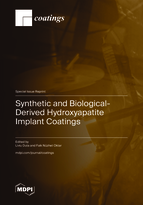Synthetic and Biological-Derived Hydroxyapatite Implant Coatings
A special issue of Coatings (ISSN 2079-6412). This special issue belongs to the section "Bioactive Coatings and Biointerfaces".
Deadline for manuscript submissions: closed (30 April 2023) | Viewed by 33905
Special Issue Editors
Interests: thin films deposition; biomaterials and protective coatings; characterization methods; natural origin calcium phosphates as sustainable biofunctional coatings for medical applications; biomimetic metallic implants
Special Issues, Collections and Topics in MDPI journals
Interests: Pulsed laser deposition (PLD); Plasma coating; Production methods of nano-biomaterials and application areas in health sector; Drug release systems; In vitro and in vivo studies; Biomimetic production methods and applications; Electro-Spinning technique and related applications; Production methods and development of bioceramics; Production of smart nano-biopolymers to be used as carrier systems
Special Issue Information
Dear Colleagues,
We warmly invite you to submit your recent work in the field of synthesis and characterization techniques of hydroxyapatite (HA) coatings to the Special Issue “Synthetic and Biological-derived Hydroxyapatite Implant Coatings”.
In the last few decades, the field of bioactive materials for bone tissue engineering has emerged as one of the prominent approaches to tackling bone traumas and ailments, with an emphasis on the production of durable implants and bone substitutes capable of bypassing rejection complications.
HA is a well-known bioceramic which possesses a close chemical and structural resemblance to the mineral composition of bones and teeth of vertebrates. Despite their favorable bone regeneration properties, HA ceramics are very brittle, and this restricts their usage in high load-bearing applications. To overcome this drawback, HA can be applied as a coating on either metallic or polymeric implants, aiming to significantly improve the implant’s overall performance by harmoniously combining the excellent bioactivity of the ceramic with the mechanical advantages of the substrate implants.
Synthetic HA is commonly produced by several chemical routes, but recent methods to either extract or derive HA from natural sustainable resources (e.g., bones, sea-shells, various mineralogical resources) were reported. Biological-derived apatite is a carbonated HA, which contains various amounts of oligoelements and has a reduced crystallinity. Therefore, it differs from synthetic HA in terms of composition, stoichiometry, crystallinity degree, crystal size/morphology, and thus, degradation rate and overall biological performance.
Moreover, commercial thick plasma-sprayed HA coatings are susceptible to cracking and delamination and, owing to the high processing temperatures, could contain residual decomposition phases. In this respect, current research interests are rapidly advancing on two focused directions: (i) Increasing the biomimicry of HA coatings with respect to the composition and structure of bone apatite, and (ii) improving the present or even discovering alternative deposition techniques to allow for the fabrication of novel (doped) HA coatings with increased mechanical and biological performance.
In particular, the topics of interest of this Special Issue include, but are not limited to:
- Synthetic and biological-derived HA coatings for orthopedic and dental implants;
- Drug delivery;
- Composite HA-based coatings;
- Doping of synthetic and biological-derived HA coatings;
- Alternative methods for the deposition of synthetic and biological-derived HA coatings;
- Biofunctional assessment of synthetic and biological-derived HA coatings.
Dr. Liviu Duta
Prof. Dr. Faik Nüzhet Oktar
Guest Editors
Manuscript Submission Information
Manuscripts should be submitted online at www.mdpi.com by registering and logging in to this website. Once you are registered, click here to go to the submission form. Manuscripts can be submitted until the deadline. All submissions that pass pre-check are peer-reviewed. Accepted papers will be published continuously in the journal (as soon as accepted) and will be listed together on the special issue website. Research articles, review articles as well as short communications are invited. For planned papers, a title and short abstract (about 100 words) can be sent to the Editorial Office for announcement on this website.
Submitted manuscripts should not have been published previously, nor be under consideration for publication elsewhere (except conference proceedings papers). All manuscripts are thoroughly refereed through a single-blind peer-review process. A guide for authors and other relevant information for submission of manuscripts is available on the Instructions for Authors page. Coatings is an international peer-reviewed open access monthly journal published by MDPI.
Please visit the Instructions for Authors page before submitting a manuscript. The Article Processing Charge (APC) for publication in this open access journal is 2600 CHF (Swiss Francs). Submitted papers should be well formatted and use good English. Authors may use MDPI's English editing service prior to publication or during author revisions.
Keywords
- synthetic and biological-derived hydroxyapatite coatings
- adherence
- osseointegration
- biocompatibility
- medical applications







